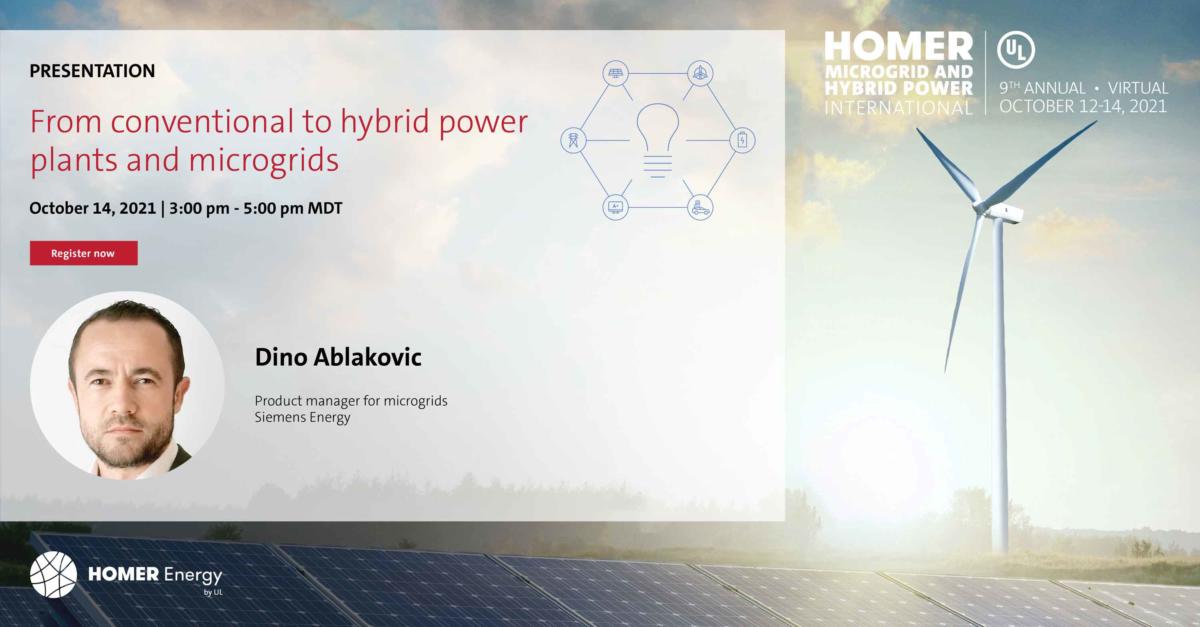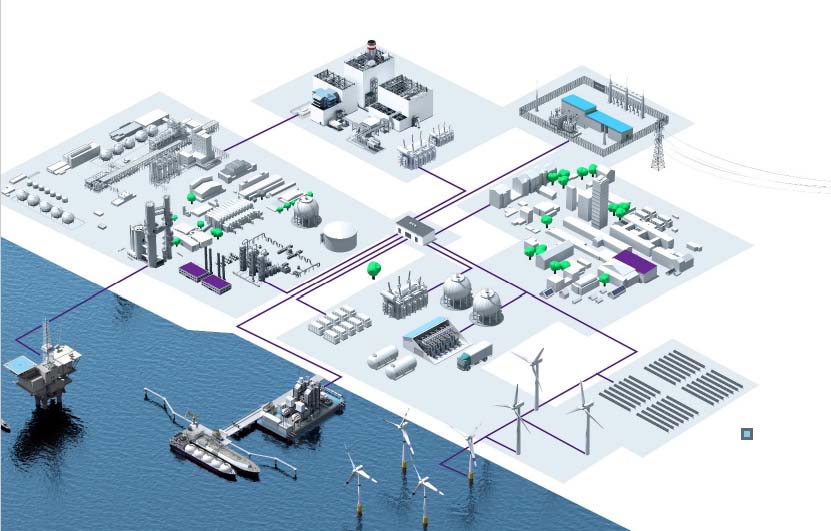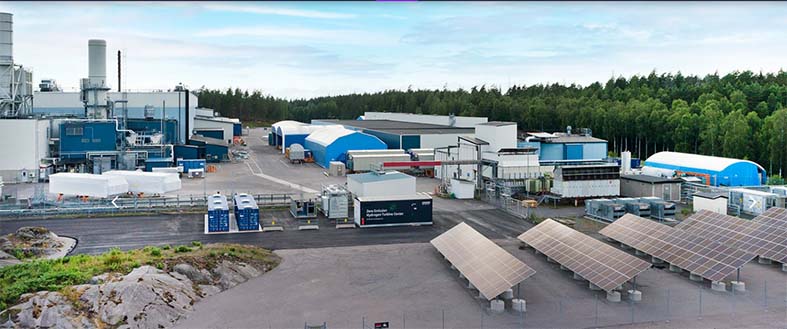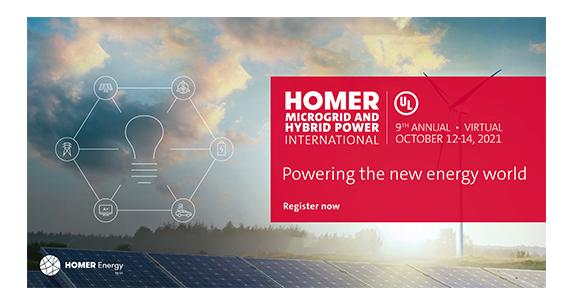A change-over is under way. Fossil-based power plants are now being decarbonized with the addition of renewable energy resources, storage and hydrogen and reconfigured as microgrids or grid-tied hybrid power plants. One company working on that challenge is Siemens Energy, a Siemens spin-off created in 2020 to help customers transition to more sustainable energy sources. We spoke with Siemens Microgrid Product Manager Dino Ablakovic about his work and upcoming presentation for HOMER Energy by UL’s 9th Annual HOMER Microgrid and Hybrid Power International conference held on Oct. 12-14, 2021.
Ablakovic will present Oct. 14 during session six, Innovative Energy Resource and Technologies: Addressing the Challenges of the Microgrid Revolution.
Microgrid News (MN): In your upcoming conference presentation, you will focus on large microgrids, grid-tied hybrid power plants and the role of hybrid control systems in managing them. Could you tell us more?
Dino Ablakovic (DA): Historically, the focus of our unit within Siemens Energy (SE) has been instrumentation and controls for conventional power plants. Decarbonization and the transition to sustainable energy sources mean that power plants are now adding renewables, batteries and more recently, hydrogen generation assets. New hybrid controls are required for these facilities.
Our solution, which combines proven technology and cybersecurity with smart functionality, was first commissioned on the hybrid power plant of Galapagos Island in 2018. Hybrid control can optimize how microgrids manage generation resources to meet their own loads and determine the most cost-efficient ways for hybrid power plants to inject power into the grid.
MN: What are some of the specific problems that hybrid control systems can solve?
DA: A hybrid control system acts as a master control for multiple resources when there are different energy assets generating power in a single geographical location. The main purpose is to ensure stable and reliable power supply. This is done with frequency and voltage control, reserve management, starting and stopping of single generation units, curtailment of renewables, charging/discharging of batteries, transitioning between on-grid and off-grid operation modes and other functions.
Secondary goals may be to reduce costs and carbon emissions, which are achieved with specific dispatch algorithms. Finally, with large microgrids there can be technical constraints such as ramping at the connection point.
MN: Could you elaborate on the connection point ramping?
DA: Any sudden, large fluctuation in the generation (intermittency) or load can cause instability in the power supply.
On large grid-tied hybrid plants and microgrids, such fluctuations can destabilize the grid. That’s why some utilities specify ramping constraints. These define the maximum change of active power over a period of time and commit the power provider to fit these requirements. Our hybrid control solution helps ensure that deviations in power production stay within the required range.

Schematic for Siemens Omnivise control system for hybrid power plants (Photo courtesy of Siemens Energy)
MN: Could you give us a few examples of your large microgrid projects?
DA: We are currently involved with several microgrids over 100 MW in size, and they are all different. These systems are more demanding because of significant local distribution grids and multiple voltage levels. Diverse energy types, such as thermal energy as steam, hot water, hot air or cooling water, are common. Mixed energy assets require complex communication infrastructure and more signals and setpoints, which makes large microgrids more complex.
MN: Are there other challenges specific to large microgrids generally?
DA: Yes, there are several. Ramping constraints are more difficult to manage with large microgrids because larger generators have slower ramping — while large PV plants can lose over 50% of their production in a matter of seconds.
Large microgrids usually have multiple voltage levels with a number of transformers and substations. Because of this, load-shedding implementation is much more complicated.
Also, protecting a large system from short circuits can be complicated. There are changing power flows depending on which assets are used and the state of the microgrid at a given point in time (off-grid, on-grid drawing power, on-grid injecting power). We solve these problems with our hybrid controller by implementing adaptive protection schemes.
Finally, a large microgrid might be connected to high-voltage transmission where connection requirements are generally stricter than on distribution grids.
MN: What challenges are specific to large microgrids in the design phase?
DA: Large microgrids require more time and effort in the design phase. At 100MW, we are controlling entire plants of which there could be several (wind, solar, etc.). When we are focusing on the role of controls, we need to complete a number of studies that model the system performance, namely power system steady-state and stability and standard short circuit and protection settings. Finally, we need to do plant sizing and energy production studies using HOMER software and other software as well.
MN: When you are decarbonizing an existing power plant, what does that process involve?
DA: In this case, we are mostly dealing with the enhancement of gas-powered plants. Siemens Energy is famous for its gas and steam turbines. Decarbonization usually means adding additional renewable and storage plants, as well as an overarching hybrid control system. The customer has to determine economically optimal sizes for the renewable and battery plants. Sometimes they already have our control systems in place, so renewable integration and hybridization are easier. Complete decarbonization of gas turbines will follow with the use of green hydrogen.

Siemens Zero Emission Hydrogen Turbine Center (ZEHTC) in Finland pilots the use of hydrogen in gas turbines (Photo courtesy of Siemens Energy)
MN: We’ve seen projections that this will be a growth year for hydrogen. Could you comment?
DA: I used to be a hydrogen skeptic, but now I’ve come around to the idea that it has the capability to transform the power sector. As a member of a European industry trade association, Siemens Energy is working to gradually increase the amount of hydrogen in gas turbines with the goal of a 100% hydrogen capability by 2030. Hydrogen is now beginning to figure into our hybrid power plants.
MN: Have you noticed any interesting microgrid trends in the past year that you could share with us?
DA: I would say that for me, the most interesting development in the world of microgrids is the grid of microgrids concept where a whole grid — even with a large proportion of transmission network — is formed from multiple microgrids. There are only a few of those which are realized, but I hope to see more.
About Dino Ablakovic
Dino Ablakovic is a microgrid product manager at Siemens Energy. He has over 12 years of experience in distribution networks and microgrids in various positions from R&D to consulting. He has worked on more than 50 microgrid projects worldwide which involve simulating, designing and consulting on microgrids of all types and sizes. He has written more than 10 papers on related topics for the Institute of Electrical and Electronics Engineers (IEEE), Springer and others. He holds a master’s degree in electrical engineering.
Learn more
Readers are invited to attend HOMER Energy by UL’s 9th annual HOMER Microgrid and Hybrid Power International, which will be virtual this year. Dino Ablakovic will present From Conventional to Hybrid Power Plants and Microgrids during the session dedicated to Innovative Energy Resource and Technologies: Addressing the Challenges of the Microgrid Revolution on Oct. 14, 2021, 3-5 p.m. MDT. This year’s conference theme, Powering the New Energy World, includes six separate online sessions over three days. Registration is complimentary.
